Address any questions or comments regarding this newsletter to the individual authors listed after each article or to its editors, Nathan Johanning, 618-939-3434, njohann@illinois.edu or Bronwyn Aly 618-695-6060, baly@illinois.edu. The Illinois Fruit and Vegetable News is available on the web at: http://ipm.illinois.edu/ifvn/. To receive or be removed from email notification of new postings of this newsletter, contact Nathan Johanning or Bronwyn Aly at the phone numbers or email addresses above.
In This Issue:
Upcoming Programs (listings for beginning and established growers)
News & Announcements (Local Foods YouTube channel URL, IL Specialty Crops Presentations Available, Jeff Kindhart Memorial Research Fund, Orchard & Vineyard survey sites, 2017 spray guides available)
Regional Reports (north-central, St. Louis metro east, southern Illinois)
Fruit and Vegetable Production and Pest Management (Integrated Strategies for Management of Spotted Wing Drosophila in Organic Small Fruit Production)
Food Safety Updates (FSMA Produce Safety Rule Update)
Upcoming Programs
Check the Illinois SARE calendar for a full list of programs and links for registration.
http://illinoissare.org/ and http://illinoissare.org/calendar.php
Also see the University of Illinois Extension Local Food Systems and Small Farms Team's website at:
http://web.extension.illinois.edu/smallfarm/ and the calendar of events at http://web.extension.illinois.edu/units/calendar.cfm?UnitID=629.
- 2017 Small Farms Winter Webinar Series, every Thursday from noon to 1:00 p.m. from January 19 – March 30, 2017.It's easy (and FREE!) to register for the Small Farms Winter Webinars. Sign up for as many as you want at http://go.aces.illinois.edu/winterwebinars2017. We'll send you a webinar reminder, log-on instructions, and how to access the archived recording. If you do not have broadband internet capable of streaming video, call your local Extension office to see if they can offer live viewing. For more information, contact: Andy Larson, University of Illinois Extension, Local Food Systems and Small Farms Educator at 815-732-2191 or andylars@illinois.edu
- Feb. 23 - Food Safety Needs for Midwest Produce Growers, Dr. Angela Shaw, Iowa State University Extension and Outreach Food Safety Specialist
- Mar. 2 - Growing Your Hobby Farm into a Business, Andy Larson, University of Illinois Extension Local Food Systems and Small Farms Educator
- Mar. 9 - Do Your Bees Have PMS (Parasitic Mite Syndrome)?, Doug Gucker, University of Illinois Extension Local Food Systems and Small Farms Educator
- Mar. 16 - Maximizing Windbreaks on Your Farm, David Shiley, University of Illinois Extension Local Food Systems and Small Farms Educator
- Mar. 23 - Benefits of Mulching Vegetables, James Theuri, University of Illinois Extension Local Food Systems and Small Farms Educator
- Mar. 30 - Soil Management for High Tunnels, Nathan Johanning, University of Illinois Extension Local Food Systems and Small Farms Educator
- Specialty Food Business Seminar Series. Christian County and Montgomery County Extension offices. The seminars will be held the second Monday of each month starting in January and ending in May. The seminars are free and the public is invited to attend any or all of the seminars they choose.
Workshops include:- Cottage Law - Monday, February 13, 2017 (1-3 pm). Presented by Lisa Peterson, Nutrition & Wellness Educator, UI Extension, on local rules and regulations for business that prepare and sale consumables.
- Importance of Branding - Monday, March 13, 2017 (1-3 pm). Featuring local vendors with regional branding experience.
- Agri-Tourism - Monday, April 10, 2017 (1-3 pm). A panel discussion, representatives from Illinois South Tourism will be part of the discussion.
- Social Media - Monday, May 8, 2017 (1-3 pm). May's topic will be presented by Terri Miller, Promotion and Publicity Specialist, UI Extension. She will address best practices for social media and current trends.
- Illinois Grape Growers and Vintners Association Winter Wine Festival and Annual Conference Crowne Plaza Springfield, IL, February 24-25, 2017. For more information, contact Elizabeth Wahle, University of Illinois Extension, Horticulture Educator at 618-344-4230 or wahle@illinois.edu
- Annie's Project - Education for Farm Women- being offered in two separate locations
Annie's Project is an educational program dedicated to strengthening farm women's roles in the modern farm enterprise.
- One location, Pittsfield, IL, will begin on Tuesday, February 28, 2017 and will meet every Tuesday and Thursday afternoon for three weeks from 1 – 4 p.m. The final session will be held on Thursday, March 16; Tuesday, March 21 is reserved as a snow day should it be needed. Sessions will be held in the John Wood Community College Center, 1308 West Washington, Pittsfield, IL. The course fee is $50.00 and includes a program binder, class handouts, resources, and 18 hours of instruction. Please pre-register online at http://web.extension.illinois.edu/abhps/ by February 22, 2016; or contact Cheryl Westfall at the Pike County Extension Office at 217-285-5543 or cwestfall@illinois.edu
- Second location, Pekin, IL, will begin on Monday, March 6, 2017 and will meet every Monday and Wednesday evening for three weeks from 5:30-9 p.m. Sessions will be held at the Tazewell Farm Bureau Building, Pekin, IL. The course fee is $75 and covers the course and materials. Please pre-register online at https://web.extension.illinois.edu/registration/?RegistrationID=15883 by February 27, 2017; or call the University of Illinois Extension office at 309-547-3711
- 2017 Midwest Cover Crop Council (MCCC) Annual Meeting, Making Cover Crops Work – Experience from the Field. Crown Plaza in Grand Rapids, Michigan, March 15th 2017. This meeting will draw farmers, researchers, agribusiness, and government agencies from across the Midwest. This year's event will feature three concurrent tracks, vegetables, row crops, and forage. Researchers and farmers will team up to present new ideas and practical application of cover crops. Participants will learn the value of covers in a production system, their role in protecting resources and their contribution to soil health. To register visit https://events.anr.msu.edu/event.cfm?eventID=DCBB51F08423699F
- What to Think About Before You Plant, 2-Part Webinar Series. The University of Kentucky's Center for Crop Diversification is hosting a two-part webinar series in March based on our publication, What to Think About Before You Plant. The first webinar, on March 7 from 3:30-4:30 p.m. Eastern time, will focus on direct-to-consumer markets such as farmers markets and Community Supported Agriculture. The second webinar, on March 14 from 3:30-4:30 p.m. Eastern time, will focus on larger scale markets, and special considerations to successfully grow your business. The webinars are free. To register, visit http://www.uky.edu/ccd/beforeyouplantwebinar .
- Produce Safety Alliance Grower Training Workshop, March 21, 2017 from 8:00am to 5:00pm, SIU Agronomy Research Center, 3268 W. Pleasant Hill Road, Carbondale, Illinois. U of I Extension in conjunction with Southern Illinois University will be holding a Produce Safety Alliance Grower Training workshop. For more information and to register online before MARCH 17th, go to https://web.extension.illinois.edu/registration/?RegistrationID=16066
News & Announcements
New Link for University of Illinois Extension Local Foods YouTube Channel
A new custom URL has been created for the Local FoodsYouTube channel. While the old, longer link will still work, please update your records with this new, shorter URL: https://www.youtube.com/c/IllinoisLocalFoods
Illinois Specialty Crop Conference Presentations Available
The presentations from the 2017 Illinois Specialty Crops, Agritoursim, & Organic Conference in Springfield this past January are now posted and available online through the Illinois Specialty Growers Association Website. Here is the direct link to the 2017 presentation PDFs: http://www.specialtygrowers.org/conference-2017-speaker-presentations.html. You can also find achieved presentation from the years as well. These presentations are great references especially if you missed the conference or a specific session or just need a refresh your memory on a topic!
Jeff Kindhart Memorial Research Fund
During the Illinois Vegetable Growers Association annual meeting on January 12, 2017, initial steps were taken to establish the Jeff Kindhart Memorial Research Fund. Jeff's work and contributions to our industry are certainly already missed and the establishment of this fund will benefit all of us in the coming years. Last year Dennis and Harry Alten transferred the funds of the Friends of St. Charles group to the IVGA treasury. The funds from the "Friends of St. Charles" are to be transferred to the Jeff Kindhart Memorial Research Fund with the intention of aiding research projects that benefit our members. With the closing of the research facilities at St. Charles and Dixon Springs, we feel that the best use of the funds would be to find appropriate projects that will continue research on those interests in the State of Illinois. Our intent is to hopefully grow this fund with additional donations so we can award grants further into the future. Contributions made to this fund would NOT be tax deductible as IVGA is not a not-for-profit organization, but continued research on specialty crops in Illinois is a benefit to all. Distributions of these research grants will be at the discretion of the IVGA board. We certainly welcome all of your input into the implementation of the research fund. Contributions to this fund may be sent to: Illinois Vegetable Growers Association c/o Matt Klein PO Box 219 Burlington, IL 60109
Brad Paulson, President IVGA (866-591-7333; bradp@ruppseeds.com)
Cooperators Wanted for Statewide Orchard & Vineyard Survey
The Illinois CAPS program is currently seeking cooperators to be part of its statewide orchard and vineyard surveys. This summer we will once again be conducting surveys focused on several invasive pests we feel are a threat to the Illinois Specialty Crops Industry. We want to identify 20 vineyards and 20 orchards/fruit growers in Illinois to participate in the surveys. Your involvement requires only permission for us to place traps in areas around your property. These traps will be clearly marked. All activities related to trap placement, monitoring, and removal are the sole responsibility of the trapping program. Biweekly visits to the property to check traps and lures will occur throughout the summer. Traps would remain in place until September. We are also in search of walnut plantings to place traps for our Thousand Cankers Disease survey.
For more information or to sign up as a survey location, please contact Kelly Estes, State Survey Coordinator, Illinois Cooperative Agricultural Pest Survey Program, University of Illinois at 217-333-1005 or email kcook8@illinois.edu
2017 Midwest Fruit & Vegetable Spray Guides Available
If you are interested in purchasing a copy of the 2017 Midwest Fruit Pest Management Guide, please contact the Jefferson County Extension Office at (618) 242-0780 or the Madison County Extension Office at (618) 344-4230.
If you are interested in purchasing a copy of the 2017 Midwest Vegetable Production Guide for Commercial Growers, please contact the Madison County Extension Office at (618) 344-4230.
Produce Safety Alliance Grower Training Course
Do you have concerns about safety in your produce operation? Are you concerned about compliance with FSMA? Do you want to know more about the difference between FSMA and GAPs? Then the Produce Safety Alliance Grower Training might be for you! Registration information included above in Upcoming Programs section.
The PSA Grower Training Course is one way to satisfy the FSMA Produce Safety Rule requirement outlined in § 112.22(c) that requires 'At least one supervisor or responsible party for your farm must have successfully completed food safety training at least equivalent to that received under standardized curriculum recognized as adequate by the Food and Drug Administration.' Compliance dates for this requirement are based on the total amount of food sales for your farm, over a three-year period:
1) Very small business – the average annual monetary value of produce sold during the previous 3-year period is no more than $250,000 – must complete training by 1/26/2020.
2) Small business – the average annual monetary value of produce sold during the previous 3-year period is no more than $500,000, and your farm is not a very small business – must complete training by 1/26/2019.
3) Other – the average annual monetary value of produce sold during the previous 3-year period is over $500,000 – must complete training by 1/26/2018.
After attending the entire course, participants will be eligible to receive a certificate from the Association of Food and Drug Officials (AFDO) that verifies they have completed the training course. To receive an AFDO certificate, a participant must be present for the entire training and submit the appropriate paperwork to their trainer at the end of the course. For more information about scheduled PSA Grower Training Courses, please visit the PSA website at http://producesafetyalliance.cornell.edu.
Please feel free to contact Laurie George (contact info at end of newsletter) directly should you have any questions. If you know of any other growers that will require training, please let them know of this workshop. Extension is committed to work with our growers and producers throughout Illinois when it comes to food safety!
Regional Reports
From north-central Illinois... "Well, this is nice," is all that comes to mind when walking outside during mid-February and highs are in the low 70s. It looks like we will have a few more days of warm weather then it is back to winter for us. I've kept a close eye on the peach, plum and apple trees growing outside my office window. So far nothing has popped. According to the chilling degree hours for our area at http://www.getchill.net/, our region has met the chilling requirement for some of our fruit trees and shrubs. However, the plants appear to be maintaining dormancy.
Temperatures in the high tunnel got up to 95 degrees Fahrenheit last Friday and probably more of the same over the weekend. Luckily, the high tunnel is empty. 2016-2017 is the first winter since beginning my high tunnel adventures in which there are no spinach, carrots, lettuce, and all the other wonderful cool season crops that one may find under plastic in Central Illinois.
This winter saw the rebuilding of raised beds, cleaning off my work table (which had become piles of used pots and the occasional mouse nest), and sweeping out my walking aisles. Speaking of mice, it seems a cat has taken to hunting in and around our high tunnel/garden at the McDonough County Extension office. Last week upon entering the high tunnel, a white-orange calico blur dashed out the rolled up side, a furry gray rodent clenched tightly in her teeth. The cat is rather plump and appears healthy. My assumption is she belongs to one of the neighbors. Since her arrival, the mouse nests have yet to return.
One item of frustration when rebuilding the raised beds is the persistence of tree roots that have grown up into my growing space. Due to the property and lack of options for building the high tunnel, this was inevitable. The tunnel is placed out of the dripline (canopy) for the nearby sycamore and red maple, but keep in mind a tree's roots can (and often do) spread 3- to 4-times the width of the dripline. Maples can be particularly notorious for their shallow roots, and I have often seen these pushing up concrete patios and creeping up into raised beds. Site your planting beds away from trees. Not only will this keep tree roots out of the way of your potato fork, but it will also prevent you from hacking away at them, which may affect the overall health of the tree.
Chris Enroth (309-837-3939; cenroth@illinois.edu)
From the St Louis Metro East... The Gateway Small Fruit and Vegetable Conference came to a successful conclusion this past Wednesday in O'Fallon, IL. For those unable to attend, color copies of the presentations will be available online early next week at http://go.illinois.edu/2017GSFVC.
Unseasonably warm weather lends itself to borrowing trouble. According to the State Climatologist, the earliest "last frost" to occur in the past 30 years at the Belleville Research Station was March 20th http://www.isws.illinois.edu/atmos/statecli/Frost/frost.htm. What this means for the fruit crop is the current topic of discussion and worry for many growers. Prime-Ark® Freedom primocane blackberries are beginning to leaf out (likely very low chill requirement), and apple and peach buds are showing some signs of swelling.
The Metro East has been dry, allowing for considerable field preparation even in low areas. As of Feb 17, soil temperatures at 4" (bare soil) was at 55.8°F. Soil temperatures 4" below sod was at 46.0°F. Horseradish growers are at least getting a jump on the season.
Elizabeth Wahle (618-344-4230; wahle@illinois.edu)

Cleaning up the old leaves is a good
sanitation practice for plasticulture strawberries.
Note the row on the left has been cleaned
up and the right row has not. Photo. B. Aly
From southern Illinois ... Well supposedly it is still winter, but it is rather hard to tell that from the weather here in southern Illinois lately. We have been unseasonably warm and this morning felt more like an April morning than a February one. Lows this week have mainly been in the 50s with highs in the 70s and a decent amount of sun most days. We did have some rain the end of last week, but overall we are fairly dry for this time of year. Looking ahead a front is supposed to bring lows back below freezing at least briefly over the weekend, but overall temperatures are still looking to be above average. I got out my soil thermometer and checked out temperature and bare soil at 4" was getting around 56˚F bare soil and lower 50s with some residue/winter annual cover. Just as a biological reference to the temperatures daffodils with a southern exposure have buds and some even blooming. My forsythias are trying to open up a few blooms as well.
Of course, fruit growers are concerned with these temperatures and buds starting to "wake up" for spring. Asparagus growers this is your fair warning that the start of spear emergence might not be too far away. Even last year, I noted seeing a spear starting to emerge as early as March 11 and that was with a rather cold February. Be prepared to make spring burndown herbicide applications in the near future if you are using any products that cannot contact spears (ie. Glyphosate, etc.). For complete listing of herbicide options consult the 2017 Midwest Vegetable Production Guide. Plasticulture strawberries are uncovered and looking very good with good branch crown development. Now is the time to go through and remove those old, dead leaves and clean up the planting.
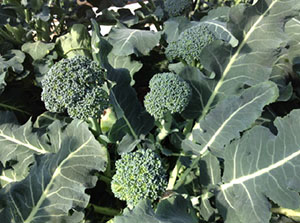
Broccoli harvest in the high tunnel.
Photo. N. Johanning.
In our high tunnel at the office, carrots are really starting to bulk up and harvest should be in a month or less. Late planted lettuce is finally starting to take off with some sun and warm temperatures. The broccoli transplanted in mid-October is still doing fairly well. It struggled through some of the cold back in January, which did in some cases damage the primary head. However, after those were harvested, we have an abundance of very nice side shoots w giving between 3 to 8 florets per plant with a diameter of 1 to 3 inches and great flavor. While we may not typically market side shoots for a grower that is looking to extend their winter offering a quart container of these fresh florets would be a nice addition. The weather may not allow this kind of growth every year, but as with any crop we have to make the most of what mother nature deals us. We are starting to get some aphids and whiteflies, and after this harvest we will remove these plants so as not to start the season off with some pest challenges in the high tunnel.
Nathan Johanning (618-939-3434; njohann@illinois.edu)
Fruit and Vegetable Production and Pest Management
Integrated Strategies for Management of Spotted Wing Drosophila in Organic Small Fruit Production
Cultural, biological and chemical control of spotted wing Drosophila in organic small fruit crops.
by Heather Leach, Matthew J. Grieshop and Rufus Isaacs, Department of Entomology, Michigan State University
Introduction
Spotted wing Drosophila (SWD) is an important pest of berries, cherries, and some thin-skinned grape varieties. The berry crops at greatest risk are raspberries, blackberries, strawberries, and blueberries. For many berry and small fruit growers, SWD has rapidly become their most critical insect pest. SWD is native to Asia and was first detected in the Midwest in 2010. It is now well-distributed throughout the United States. Female SWD have a saw-like egg laying device that can cut into ripe or ripening fruit and deposit an egg (Figure 1). The resulting larvae degrade the fruit from the inside, increasing the risk of fungal pathogens and other pest damage. Larvae go through three larval stages within the fruit. The larger larvae are visible to the naked eye, creating concern of noticeable fruit contamination.
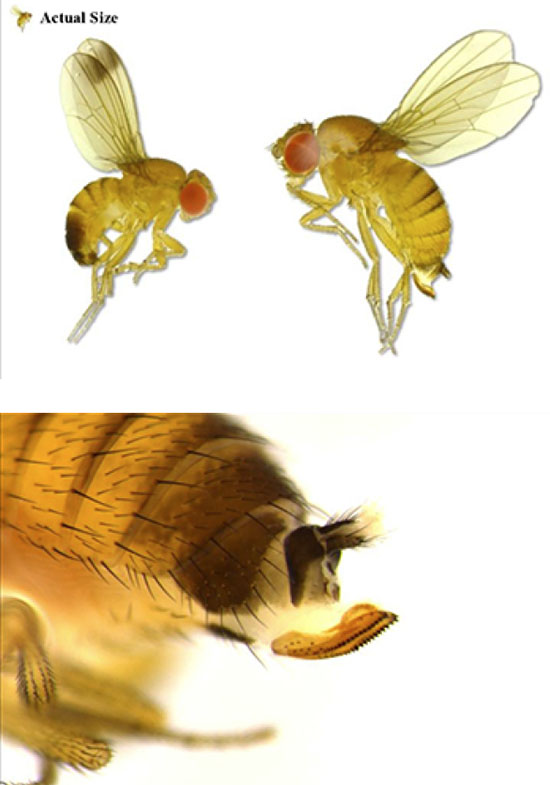
Fig. 1. Spotted wing Drosophila (SWD), male (top left), female (top right), and the
females serrated ovipositor (bottom). Actual size of the fly is shown in the top left corner.
In Michigan's southern peninsula, first SWD fly activity is typically in mid-June to early July and the population builds through the summer as temperatures continue to rise. Highest densities of SWD occur in August and September, so SWD is especially problematic for later-season berry crops, including blackberries, fall raspberries, ever-bearing strawberries, and late-season blueberries. Adults live for two to three weeks and females can lay more than 300 eggs, so they have the capacity for many generations per growing season. Typical IPM programs for pests including cherry fruit fly and blueberry maggot will not provide sufficient control of SWD. Its host range, fast generation time, and damage characteristics make it an extremely challenging pest to manage.
Conventional management programs rely on the frequent use of pyrethroid, spinosyn, organophosphate, carbamate and neonicotinoid insecticides. Of these chemical classes only the spinosyns are available to organic producers. This means that other control measures must be implemented to control SWD in organic berries.
Integrated Pest Management (IPM) programs for SWD consist of three major components: 1) the use of preventative pest management tactics, 2) monitoring and sampling for populations, and 3) the judicious use of National Organic Program (NOP) insecticides or other responsive pest management tactics. Growers should design IPM programs that emphasize management practices (e.g. exclusion, sanitation, resistant varieties), followed by the use of mechanical, biological or physical methods (e.g. hand removal, cultivation, release of predators/parasites, provision of predator/parasite habitat biological control), and resorting to NOP compliant insecticides only when necessary. In the case of SWD, insecticides are typically needed, but organic growers should integrate preventative cultural, physical and biological tactics into their SWD management programs as much as possible to help ensure effective control.
Monitoring, Identification & Thresholds
SWD can be monitored using a simple homemade trap or by buying traps (e.g. Great Lakes IPM). Traps should be placed in your field before fruit begins to ripen to identify if this pest is active. It is best to have multiple traps in each field, and at least one trap should be at the border of your crop, nearest a wooded edge where SWD activity may be earlier. Traps should be hung within the plant canopy in a shaded area and checked weekly. If creating homemade traps, we suggest using a 32 oz. plastic cup with ten 3/16" to 3/8" holes melted or cut within 2" of the top (an in-depth guide to trap construction can be found at http://goo.gl/yL2uo8). The small holes allow SWD to enter but prevent entry of larger insects. A yellow sticky trap can be placed on the inside for capture and faster identification of SWD.
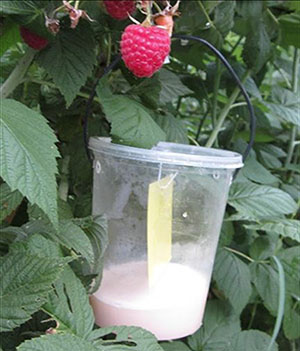
Fig. 2. A yeast-sugar baited monitoring trap with
a yellow sticky trap hung within a raspberry canopy.
Traps must be baited to attract SWD. An effective homemade bait can be made by combining 1 tablespoon active dry yeast, 4 tablespoons sugar, and 1.5 cups of water. The bait should be added to the trap with a 1" depth. Alternatively, you can use a commercially available lure. The Scentry lure (Scentry Biologicals, Inc.) is a gel sachet that has catch rates comparable to the yeast-sugar bait but in a non-liquid formulation, allowing for less mess and easier identification of SWD. Non-liquid lures should be used with a 1" deep drowning solution of water and a drop of unscented soap. Check traps weekly for SWD, record the catches, and replace the liquid bait or drowning solution. Commercial lures vary in longevity, but generally will last at least four weeks.
Spotted wing Drosophila lures are attractive to other insects, including other vinegar flies, so it is important to know how to identify SWD. They are small (~1/10 inch in length), so identification requires a 10x hand lens. Adult flies are golden brown in color and have red eyes. Male SWD can be identified from a single dark patch near the tip of each wing (Figure 1). Wing spots darken with age, so spots may not be apparent on young male SWD. Females lack wing spots, but can be identified by their egg-laying device, which is dark in color with small tooth-like serrations (Figure 1).
Sampling for larvae in your fruit can help you monitor the fruit marketability status and to know whether management actions are working. To sample from a planting, place at least 15 ripe fruit in a plastic bag. Lightly squeeze each fruit. Add in a strong salt solution (1 cup salt to 1 gallon water). The solution should be enough to cover all of the fruit in the bag. If they are present, small white SWD larvae will emerge and rise to the top of the liquid after 30 minutes (Figure 3), and can be counted. We recommend sampling from multiple areas of your crop with emphasis on the edge and interior of your fields. Typically, the edge will have higher infestation than the interior. Having samples from multiple locations will allow you to focus management on heavily infested areas. You may not see adult SWD in traps before you find larvae in your fruit, and so we recommend monitoring for larvae and adults throughout your crop season so no unsuspected infestations develop. Visit http://goo.gl/bJf0CG for a more complete guide to the sampling process.
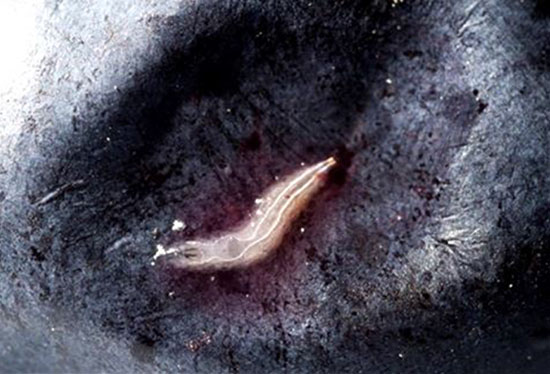
Fig. 3. A large late-instar SWD larvae on the surface of a blueberry.
Sampling Fruit for SWD Larvae
- Pick 15-25 ripe fruit.
- Lightly squeeze each fruit.
- Mix fruit with a strong salt solution (1 cup salt in 1 gallon water) in a resealable bag.
- Wait 30 minutes.
- Look for small white larvae floating on the top.
- Repeat from multiple locations in your field, especially near the field edge.
Other insects, especially native fruit flies, look similar to SWD. Thus proper identification is extremely important. You can get help with the identification of adult or larval SWD from your crop consultant or your local extension agent. The best way to monitor for SWD is to use traps for the adults and take fruit samples for larvae. However, certain types of damage on your fruit could also indicate SWD infestation. This includes soft spots or scarring on the skin, wrinkled skin, and collapsed areas on the fruit. Leaky berries is another symptom and in raspberry plantings, red patches of juice left on receptacles after picking a berry is another tell-tale sign of infestation.
If any SWD are found in traps or Drosophila larvae are found in the fruit samples, control actions should be taken immediately. Many conventional berry and cherry growers begin insecticide applications as soon as one fly is detected in their field and the fruit are ripening or ripe. Implementing your cultural controls before this detection will help keep populations from growing quickly. It is also important not to delay responding to detection of infestation as this pest can build populations very quickly.
Cultivar Selection
Planting early-ripening varieties of blueberries, including Duke, Draper, and Bluecrop can help to decrease your chances of intense SWD infestation. In raspberries, some growers have chosen to only produce a summer crop, avoiding the heavy infestation in fall raspberries altogether. June-bearing strawberries are typically at low-risk of SWD infestation, but ever-bearing strawberries have a higher risk in later parts of the summer. SWD is less successful and takes longer laying eggs in thicker-skinned fruit, so it may be beneficial to select fruit varieties with thicker skins. Grapes are not a preferred host for SWD and most grape producers have not had major issues with SWD. However, grape varieties with thinner skin or those that have splitting are more vulnerable to SWD infestation and the associated sour rot infections.
Many extension programs will provide weekly updates on SWD captures in your region. Staying connected with these updates, especially as your fruit begin to ripen, will help you better prepare. If you are in Michigan, find these reports at: www.ipm.msu.edu/invasive_species/spotted_wing_drosophila
Sanitation
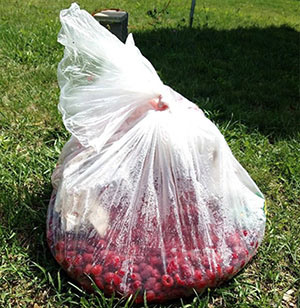
Fig. 4. Waste fruit disposed of in a clear trash bag.
Over-ripe and damaged fruit can act as a reservoir for SWD and other pests, increasing their populations and making them even harder to control. Some U-pick operations have customers collect damaged fruit as they pick, others send crews through after the customers leave to remove remaining over-ripe berries. Don't leave waste piles of fruit in the open. They should be bagged, burned, or frozen. If bagging the fruit, use a clear trash bag and leave in the sun for at least 48 hours to kill the larvae (Fig. 4).
SWD has a broad host range and will infest other non-crop plants, especially those that produce small fruits including wild raspberry, blackberry, honeysuckle, and American pokeweed. If these wild plants surround your field edge, they could act as a refuge for SWD. Early producing plants, such as honeysuckle, give SWD a place to develop and increase populations before crops ripen. Initial trials in Michigan suggest that SWD populations may increase faster in areas where honeysuckle is present. If these plants are present in high density on the edge of your crop, such as a bramble patch, removing these could decrease the onset and severity of the SWD population to your crop. However, this has not been well tested and removal of wild hosts is not guaranteed to reduce SWD populations.
Pruning and Harvest Frequency
SWD's small size means that it is very susceptible to desiccation (drying out), so they prefer more humid areas like inside the crop canopy and low to the ground. You can use this to your advantage by keeping plants well pruned. This has the double benefit of reduced canopy humidity as well as improving spray coverage, both of which can reduce SWD survival. Harvest frequency also plays a major role in the development of SWD infestation. Harvest fruit daily or every other day to minimize infestation. Harvest intervals of three or more days significantly increase the prevalence of SWD larvae found in raspberries (Figure 5). In our trials, harvesting every 2 days provided the greatest yield per hour in raspberries.
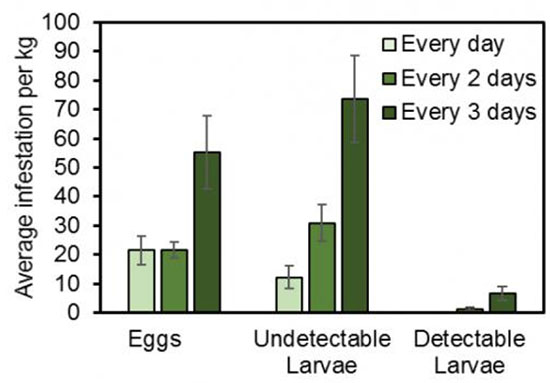
Fig. 5. The number of eggs, undetectable larvae (1st and 2nd instars) and detectable larvae (3rd instars) per kilogram of raspberries when harvested daily, every 2 days, and every 3 days.
Exclusion Netting
Physically excluding SWD flies from your crop can provide good control, and may be especially relevant for high-value crops like berries and small fruit. High tunnels or bird netting structures can both be modified for use of insect exclusion nets, but it should be at least 80 gram netting to keep flies out. Netting in our trials was purchased from Berry Protection Solutions in Stephentown, NY and manufactured by Tek-Knit Industries. We found an average reduction of 73% and a 4 week delay in SWD eggs, larvae, and adults in the netted high tunnels covered with 80 gram netting. Additionally, we've found that using netting in combination with insecticidal applications can provide better reduction of SWD infestation than either netting or insecticides alone. However, unless the netting is completely sealed, you can expect colonization within the protected structure and infestation of the fruit.
Access doors can be designed to best fit the needs of the farm practices (Figure 6). To allow for a tractor-mounted sprayer, barn style wooden doors can be constructed and fitted with netting. If only a backpack sprayer is required, a door sealed by a magnetic strip, zipper, or a vestibule can be constructed. Netting the perimeter of a series of high tunnels may also provide adequate control. Netting the perimeter of five tunnels (one acre) with netting is estimated to cost $6,100 (Figure 7). The lifespan of the netting is predicted to be seven years and so this cost can be amortized over these years. We also expect that with practice, labor costs would decrease.
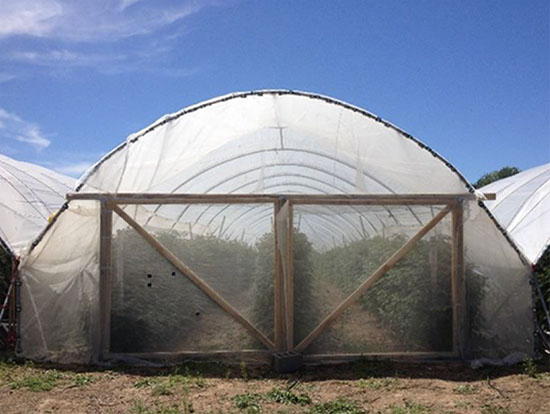
Fig. 6. Exclusion netting fitted to a high tunnel raspberry system, with doors to allow for
sprayer access.
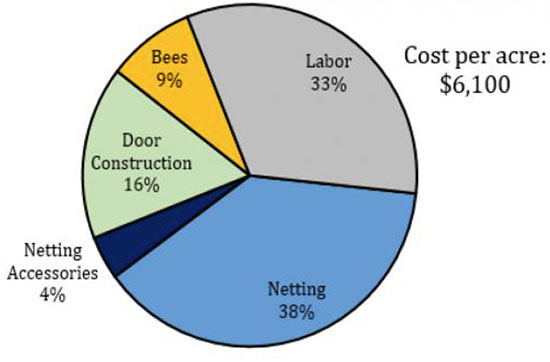
Fig. 7. The estimated cost to cover the perimeter of 1 acre of high tunnels (five 400ft
tunnels) in 80 gram netting.
Holes from equipment, storms, etc. will need to be patched – taping both sides or using thick thread to sew the hole together are viable repair methods. For summer-blooming raspberries, bumble bees or other pollinators should be stocked to ensure pollination. In other crops like blueberry with spring bloom, netting can be applied after pollination is complete. In our trials in Michigan, netting had no effect on temperature or fruit quality (size, sugar content, or weight), but in warmer climates, exclusion netting has the possibility of increasing the temperature and degrading fruit quality. Exclusion netting may also provide control of other insects, birds, and some rodent pests.
Attract-and-Kill
Attract-and-kill approaches use attractants to bring the target insect to a location where they are killed. Killing can be achieved through trapping or through delivery of a contact insecticide. At present there are no labeled attract and kill devices for SWD but several are being developed by university entomologists. Research suggests that attract and kill may improve control of SWD but is likely to require a large number (500+/acre) of killing devices to impact SWD populations. This approach could be carried out by using a large number of monitoring traps and is best suited to small (<1/4 acre) plantings.
Biological Control
There are some native parasitoid wasp species and some predators that have been reported to attack SWD in the U.S., and research of this is ongoing. Currently, we have very limited knowledge of predators or parasitoid wasps that attack SWD in the Midwest. Native predation of SWD is likely to only occur at high population levels of SWD and crop infestation would still be apparent. Research is underway on the potential to introduce parasitoid wasps from Asia, SWD's native range, for control.
Chemical Control
There are few NOP compliant insecticides that provide effective SWD control. Entrust® (spinosad) has been found to be the most effective of these, but it must also be rotated with another insecticide after two applications for resistance management. Pyganic® can be rotated with Entrust®, but has demonstrated limited efficacy and short residual for SWD. Grandevo® is another organic rotation partner that can be used with Entrust®, and this has provided variable control within the U.S. In Michigan, initial trials with Grandevo® have shown efficacious control when rotated with Entrust®.
The limited availability of effective organic SWD insecticides and label restrictions on Entrust® make spray coverage and timing of applications critical to achieving control. Sprayers should be calibrated at least once per year and appropriate spray volumes used to achieve excellent coverage. Initial research suggests that SWD are active during cooler parts of the day, in the morning and at dusk. Targeting sprays during these times may increase efficacy. When bees are present in your crop, avoid insecticide applications. If control is needed, use insecticides less toxic to bees and do not spray when they are active.
Entrust SC Label Restrictions by Crop |
||||
|---|---|---|---|---|
Crop |
Blueberry |
Raspberry, Blackberry |
Strawberry |
Stone Fruit |
Application Rate |
4-6 fl oz/acre |
4-6 fl oz/acre |
4-6 fl oz/acre |
4-8 fl oz/ acre |
PHI |
3 days |
1 days |
1 days |
7 days |
Retreatment Interval |
6 days |
5 days |
5 days |
7 days |
Max Amount |
29 fl oz per year |
29 fl oz per year |
29 fl oz per year |
29 fl oz per year |
Max No. Applications |
6 per year |
6 per year |
5 per year |
3 per year |
Post-Harvest Cooling
If fruit are suspected of having some infestation by SWD after being harvested, they should be cooled as soon as possible to stop further development of the insect. Cooling to 35°F will stop the development of the eggs and larvae inside the fruit, which can prevent them from becoming larger and noticeable. Cooling the fruit for three days has been shown to kill SWD larvae. If your fruit is sold directly to consumers, you should advise them to keep it in the refrigerator. Freezing the fruit will kill eggs and larvae of SWD.
Summary
We emphasize that controlling SWD requires a rigorous, persistent, and diverse management plan. Using as many possible control techniques on your farm will help to reduce SWD infestation. For effective management, follow these key points:
- Monitor fields with traps and check them weekly, especially when fruit is ripening.
- Monitor SWD infestation by testing ripe fruit samples in a salt solution before and during harvest.
- Take management actions when SWD are detected and fruit are ripening or ripe. This includes increasing your harvest frequency, keeping your fields well-pruned and clean, removing and destroying leftover fruit, and using recommended NOP compliant insecticides.
- Track the effectiveness of your management programs with continual monitoring throughout the season.
- Stay informed with your regional SWD counts and new management techniques using the resources below.
References and Resources
For more information, check the Michigan State University SWD page online at www.ipm.msu.edu/SWD.htm
For identification help, contact your local extension agent or find keys at www.ipm.msu.edu/SWD.htm
For research updates, go to www.spottedwing.org
This fact sheet was produced with support from USDA-SCRI TunnelBerries project supported by the National Institute of Food and Agriculture, U.S. Department of Agriculture, under Agreement No. 2014-51181-22380, the USDA-NIFA Organic Agriculture Research and Extension Initiative Grant Agreement No. 2015-51300-24154, and the North Central Region Sustainable Agriculture Research and Education program Award 2014-38640-22156.
MSU is an affirmative-action, equal-opportunity employer, committed to achieving excellence through a diverse workforce and inclusive culture that encourages all people to reach their full potential. Michigan State University Extension programs and materials are open to all without regard to race, color, national origin, gender, gender identity, religion, age, height, weight, disability, political beliefs, sexual orientation, marital status, family status or veteran status. Issued in furtherance of MSU Extension work, acts of May 8 and June 30, 1914, in cooperation with the U.S. Department of Agriculture. Ray Hammerschmidt, Interim Director, MSU Extension, East Lansing, MI 48824. This information is for educational purposes only. Reference to commercial products or trade names does not imply endorsement by MSU Extension or bias against those not mentioned.
This fact sheet was reprinted by permission from Dr. Rufus Isaacs, Michigan State University, and a direct link can be found at the website below. There is also a downloadable format for the fact sheet at this link as well.
http://msue.anr.msu.edu/resources/integrated_strategies_for_management_of_spotted_wing_drosophila_in_organic
Food Safety Updates
FSMA Produce Safety Rule Updates
Regardless of how we might feel about it, the Food Safety Modernization Act (FSMA) and the Produce Safety Rule is here (http://www.fda.gov/Food/GuidanceRegulation/FSMA/ucm334114.htm ). Compliance dates for some operations are quickly approaching:
|
COMPLIANCE DATE |
|||
PROVISIONS |
COVERING |
Very Small ($25k - $250k Produce Sales) |
Small ($250K - $500K Produce Sales ) |
Other ($>500K Produce Sales) |
|---|---|---|---|---|
112.44, 112.45(a) and (b) |
Certain water provisions dealing with E. coli based agricultural water quality criteria |
1/26/2022 |
1/26/2021 |
1/26/2020 |
Part 112, except as otherwise noted |
Remainder of the Rule |
1/26/2020 |
1/26/2019 |
1/26/2018 |
Farms that have an average annual value of produce sold during the previous three-year period of $500,000, or more, must be compliant with the Produce Rule by January 26, 2018. Smaller farms have until 2019 or 2020 to become compliant. For the agricultural water criteria, compliance dates will be two years later, based on average produce sales.
If your farm falls under the Preventative Controls rule, compliance dates for some businesses began on September 2016. To see if your business falls under this rule, review the FDA publication on "Final Rule on Preventive Controls for Human Food" http://www.fda.gov/Food/GuidanceRegulation/FSMA/ucm334115.htm.
There are two other publications available to help answer your questions. The first is "GAPs Certification/FSMA Produce Safety Rule Comparison" (http://web.extension.illinois.edu/smallfarm/cat129_4491.html), developed in cooperation with the Produce Safety Alliance, Kansas State and University of Missouri Extension to assist growers in understanding the GAPs and FSMA differences. The second publication "Am I affected by the new Food Safety Rules under the Food Safety Modernization Act? (http://sustainableagriculture.net/wp-content/uploads/2016/02/2016_2-FSMA-Final-Rule-Flowchart-V3.pdf), is from the National Sustainable Agriculture Coalition (NSAC). While the FDA has its own flow chart for each sub-rule under FSMA, the NSAC chart ties the two most relevant rules together that likely affect the bulk of this readership. These are the Produce Safety Rule and the Preventative Controls or Facility Rule. Some growers may fall under both, others just the produce safety rule. Follow this flow chart carefully to determine how both rules apply to your operation. Several additional links within the flow chart help define important distinctions between facilities definition and "secondary farm activities", and other concepts like the qualified exemptions. If you have any questions or need further clarification, please contact Laurie George, James Theuri, or Zachary Grant. Our contact info is at the end of this newsletter.
The attached graphic below is an attempt to clear up some confusion about this very broad topic of food safety on farms and the different trainings, rules, and certifications. The three bubbles represent the areas that are often most confusing for growers not familiar with FSMA or GAPs. No matter the size of your operation and/or whether you will have a qualified exemption to FSMA, or will never participate in a 3rd party GAP audit, food safety still affects everyone. Farms should undergo some form of training or study to understand the best food safety practices that apply to your operation and know how to implement them. Only a farmer can understand food safety in the context of their operation and can ultimately take lasting steps to reduce potential risks. The other thing to keep in mind is that while FSMA has qualified exemptions for some farms, and does not require a food safety plan at this time, it is possible for them to remove the qualified exemption if an operation is associated with an outbreak. While there is an appeals process and ultimate ability to reinstate the exemption, understanding what records and documentation are required of FSMA in order to potentially comply is a good idea. A food safety plan is the best way to manage these records, standard operating procedures, and documentation. Online training for growers that fall under the FSMA Produce Rule has not been approved by the Produce Safety Alliance at this time. Illinois will have its first grower training on March 21, 2017 in Carbondale, Illinois. Information for this training can be found at https://web.extension.illinois.edu/registration/?RegistrationID=16066. If you are wanting to schedule a grower training in your area, please contact Laurie George, James Theuri, or Zachary Grant.
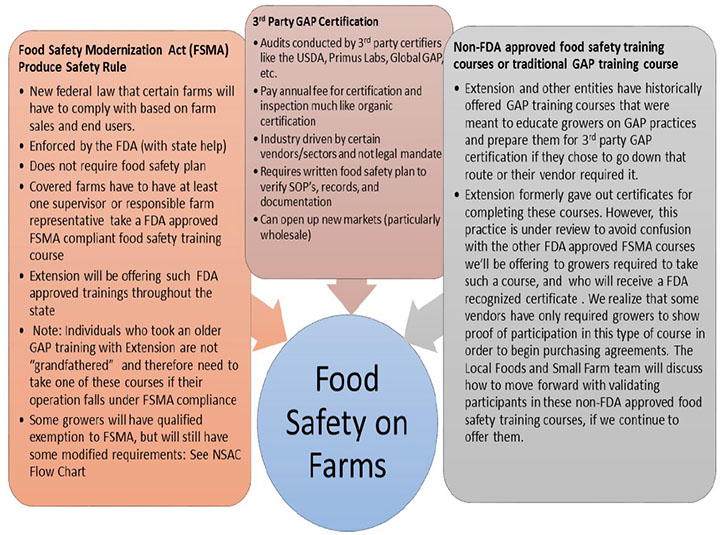
Zachary Grant (708-449-4320; zgrant2@illinois.edu)
Less Seriously...
https://www.brainyquote.com/quotes/keywords/spring.html
Spring is when you feel like whistling even with a shoe full of slush. – Doug Larson
We would load up the yellow Cutlass Supreme station wagon and pick blackberries during blackberry season or spring onions during spring onion season. For us, food was part of the fabric of our day. – Mario Batali
The very spring and root of honesty and virtue lie in good education. - Plutarch
The weather here is gorgeous. It's mild and feels like it's in the eighties. The hot dog vendors got confused because of the weather and thought it was spring, so they accidentally changed the hot dog water in their carts. – David Letterman
In the Spring, I have counted 136 different kinds of weather inside of 24 hours. – Mark Twain
University of Illinois Extension Specialists in Fruit and Vegetable Production & Pest Management
Extension Educators – Local Food Systems and Small Farms |
||
Bronwyn Aly, Gallatin, Hamilton, Hardin, Pope, Saline, and White counties |
618-382-2662 |
|
Katie Bell, Franklin, Jackson, Perry, Randolph, & Williamson counties |
618-687-1727 |
|
Sarah Farley, Lake & McHenry counties |
847-223-8627 |
|
Nick Frillman, Woodford, Livingston, & McLean counties |
309-663-8306 |
|
Laurie George, Bond, Clinton, Jefferson, Marion, & Washington counties |
618-548-1446 |
|
Zachary Grant, Cook County | 708-679-6889 | |
Doug Gucker, DeWitt, Macon, and Piatt counties |
217-877-6042 |
|
Erin Harper, Champaign, Ford, Iroquois, and Vermillion counties |
217-333-7672 |
|
Grace Margherio, Jackie Joyner-Kersee Center, St. Clair County |
217-244-3547 |
|
Grant McCarty, Jo Daviess, Stephenson, and Winnebago counties |
815-235-4125 |
|
Katie Parker, Adams, Brown, Hancock, Pike and Schuyler counties |
217-223-8380 |
|
Kathryn Pereira, Cook County |
773-233-2900 |
|
James Theuri, Grundy, Kankakee, and Will counties |
815-933-8337 |
|
Extension Educators – Horticulture |
||
Chris Enroth, Henderson, Knox, McDonough, and Warren counties |
309-837-3939 |
|
Richard Hentschel, DuPage, Kane, and Kendall counties |
630-584-6166 |
|
Andrew Holsinger, Christian, Jersey, Macoupin, & Montgomery counties |
217-532-3941 |
|
Extension Educators - Commercial Agriculture |
||
Elizabeth Wahle, Fruit & Vegetable Production |
618-344-4230 |
|
Nathan Johanning, Madison, Monroe & St. Clair counties |
618-939-3434 |
|
Campus-based Extension Specialists |
||
Kacie Athey, Entomology |
217-244-9916 |
|
Mohammad Babadoost, Plant Pathology |
217-333-1523 |
|